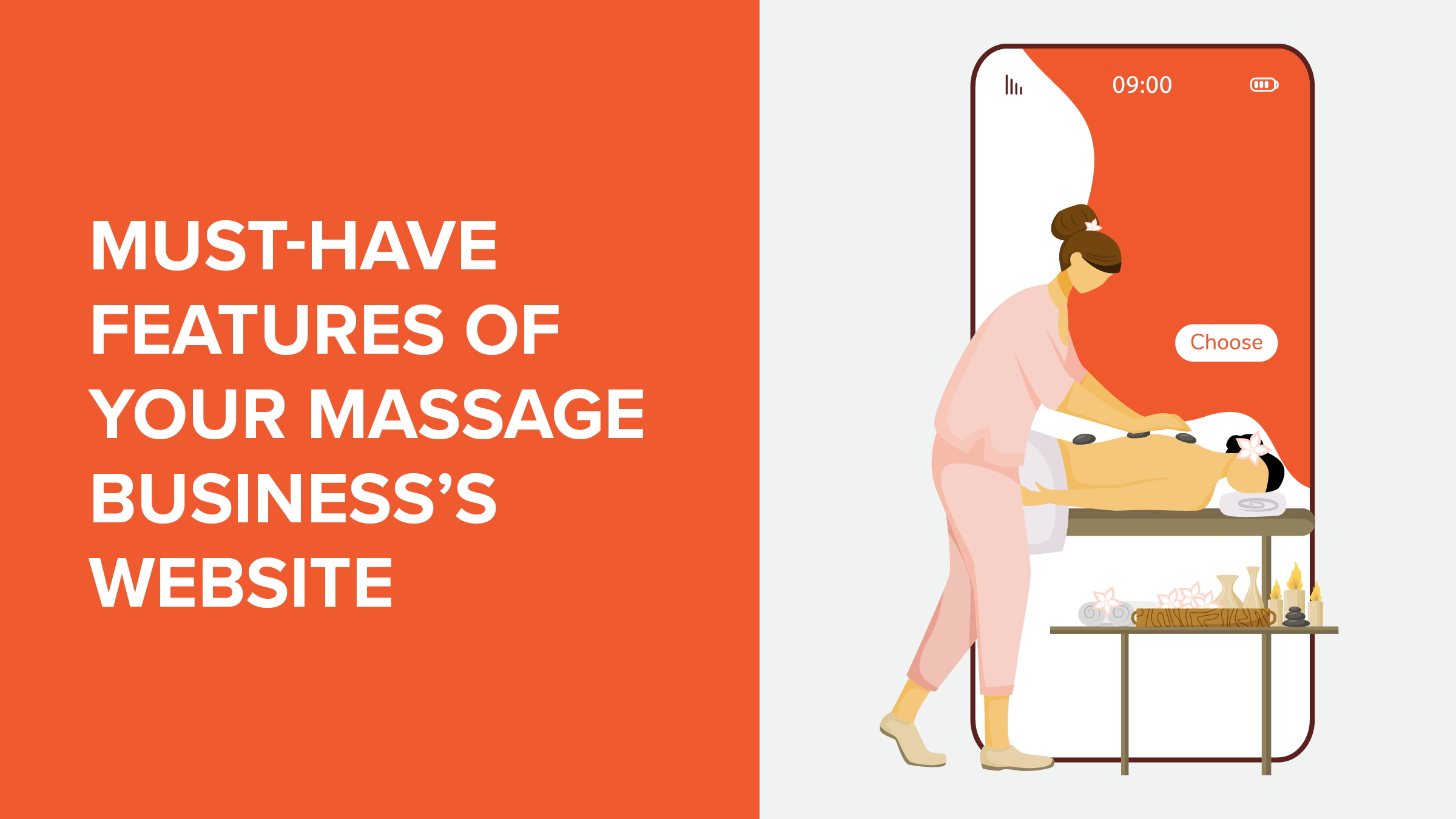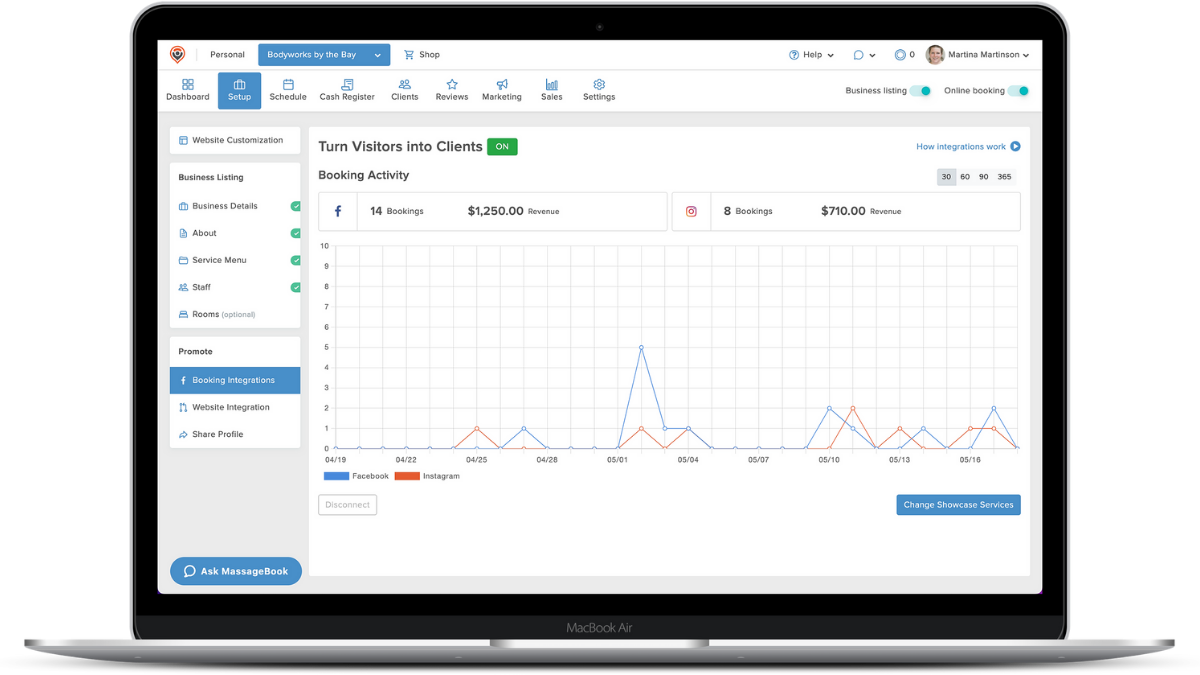Contents
Whether you're launching your first website or looking to revamp your current site, here are the must-have features for your massage therapy website. With the right capabilities, you can transform your website into an all-in-one marketing tool that helps you drive the results you seek.
1. Online Booking System
When visitors land on your website, you have one main goal: to encourage them to schedule an appointment! An online booking system is a crucial feature for this, as it simplifies the appointment scheduling process for both you and your clients.
Your system should make it easy to choose a service, read the description, and select an open time block from various days and times. Once a booking is complete, it should allow the customer to add the appointment directly to their calendars. Additionally, the system should sync directly with your business calendar. This ensures that you and potential clients always know your availability.
When choosing an online booking system, look for one that integrates seamlessly with your website and allows customization to suit your specific needs. Features like real-time availability, instant confirmation, and cancellation and rescheduling management are essential.
Pro tip: To reduce no-shows, ask people to pay a certain percentage of their fees when booking the appointment. People are less likely to no-show an appointment they’ve already paid for. If you choose to do this, ensure your cancellation policy is printed clearly and obviously on your booking page.
2. Contact Information and Location
It’s not enough for clients to be able to book an appointment—they also need to know where to go for their appointment! Include the following details on your website to help them do so:
- Phone number and email: Display these prominently on your homepage and contact page. Bonus points if they can click your phone number to call you directly!
- Address and map: Provide your address along with a Google Map for easy navigation.
- Contact form: Offer a simple form where clients can send inquiries not answered by your other website elements.
Additionally, consider adding a live chat feature to offer instant assistance to website visitors.
3. Clear Service Descriptions
Your website should list all your services to help potential clients understand what to expect, how your services differ, and the potential benefits. This empowers them to make educated decisions and feel confident when booking your services.
Here’s what to include:
- Service Name and Description: Explain what the service entails and its benefits.
- Duration and Pricing: Provide the length of the session and the cost.
- Special Instructions: Mention any preparation clients need to do before the session. You can also state if there are any stipulations (e.g., this service is not recommended for pregnant women).
This is also a great strategy for appealing to clients who have a specific service in mind when they check your website. For example, if you offer sports massages, visitors looking for this service will be more likely to schedule an appointment at your massage business after reading a thorough description. Or, if someone is specifically looking for aromatherapy and their favorite scent is geraniums, they’ll want to schedule an appointment once they see you use geranium essential oils.
4. High-Quality Images and Videos
Have you ever stepped into a business that feels outdated and unpopular? That’s how visiting a website with grainy, out-of-focus images feels. High-quality images and videos are essential to showcasing your brand’s professionalism. This first impression on your website goes a long way toward establishing expectations and trust with your potential clients.
Show off your massage therapy space, team, and personality with photos such as:
- Relaxing aesthetic shots: These images are purely decorative but convey the mood that your massage business embodies. You can look for stock images or take photos of tranquil, clean, and relaxing spaces and objects.
- Massage therapy room: Let clients see the room where you provide massages so they know what to expect. If you have multiple rooms, add photos of all of them to help clients better understand your space.
- Staff Photos: Introduce your team with professional photos and brief bios. Share relevant fun facts about them as well, such as their favorite massage techniques or how long they’ve been practicing.
Videos are another great way to separate yourself from the competition. Add short snippets of you or your staff members demonstrating different massage techniques to engage web visitors and entice them to schedule an appointment. You can even add a few filmed testimonials from previous clients—more on this in the next section!
5. Client Testimonials and Reviews
Client testimonials and reviews establish trust and increase your business’s credibility. Positive feedback from satisfied clients reassures potential clients of the quality of your services. If you have many testimonials to include or plan to link to them from your other marketing channels, create a separate page for client testimonials.
Include the client’s first name and last initial on your testimonials to preserve anonymity while maintaining credibility. Having a real name associated with each review assures web visitors that your testimonials aren’t made up—or written by your mom! Just be sure to get the client’s permission before adding their testimonial to your site.
If you have enthusiastic clients, video testimonials can be even more powerful. To capture these, set up a tripod in a dedicated space with as much natural light as possible. Simply put your phone there and let your clients sing your praises. If you need to clip the beginning or end of the videos, plenty of simple video editing software platforms are available to help. We recommend CapCut and Canva!
You can also integrate reviews from third-party platforms like Google My Business, Yelp, or Facebook to provide an unbiased perspective. MassageBook allows you to list Google Reviews on your custom website with a few clicks of a button.
6. Mobile Optimization
With the increasing number of people using mobile devices to browse the internet, a mobile-friendly website is no longer optional; it's necessary. Did you know that 58% of global website traffic comes from mobile devices? This means your website should be optimized for mobile devices and should render properly, no matter the visitor’s screen size.
Not sure if yours does? Open the window as large as possible and slowly reduce the window size by pulling up the bottom right corner. Does everything automatically resize and organize based on the window size? Then you should be good to go! You can also directly check your website on your own mobile device and see how it performs there.
If your site isn’t mobile-responsive, consider working with a massage therapy software provider that offers mobile-optimized websites. You can also look for a content management system (CMS) with built-in mobile optimization tools.
7. Social Media Integration
Integrating your social media accounts with your website can help you grow your online presence and update clients with your latest news and offers. Include social media buttons that link to your profiles on platforms like Facebook, Instagram, and X (formerly Twitter) so web visitors can browse more of your content.
However, only include the social media profiles you keep updated. You don’t want someone to click one of the icons to find no updates in the last six months.
Remember, your website is often the first impression potential clients will have of your business, so make it count! A well-designed website with the right features can significantly enhance your massage therapy business, attracting new clients and improving the overall client experience. With these seven features, you can build a strong online presence and set your business apart from the competition.

.png)




